|
https://ift.tt/3le5hp1
3D Printing News Briefs, July 31, 2021: Student Racing and More https://ift.tt/3lfFcWt We’re covering a software release and new composite materials in today’s 3D Printing News Briefs, followed by 3D printing used in Formula Student racing, to make metrology components, and to make bollards. Read on for all the details! CAD Exchanger 3.10 Released CAD Exchanger announced that it has released CAD Exchanger 3.10, the latest and greatest toolset for 3D CAD end-users and software developers. Some of the new features in this release include a Solid Edge import, which means that the software now supports Solid Edge files from versions 17-21, and a mesh colors import in SOLIDWORKS to improve the usability of scenarios where standalone SOLIDWORKS assemblies that have missing components are converted to mesh. Additionally, there are some new features for CAD application developers, such as a universal reader and writer API and Unity integration enhancement. Other features include broader versions coverage for CATIA, Parasolid, JT, and SOLIDWORKS, read and write PMI options for STEP and JT, and more.
3D Printable PCM Composites Regulating Temperature 
New phase-change material composites can regulate ambient temperatures inside buildings. Image courtesy of Dharmesh Patel. Moving on to research out of Texas A&M University, a team there published a study on their work creating novel, cost-effective 3D printable phase-change material (PCM) composites that can actually regulate ambient temperatures inside a building; the study was funded by the National Science Foundation’s Division of Materials Research Career Award. HVAC systems are often used to regulate interior temperatures, but they’re not very energy-efficient, and also use greenhouse materials. Depending on the temperature of the surrounding environment, PCMs can change their physical state, and regulate temperature without any external electricity required. These composite materials can also be added to building materials like paint, and even fabricated as decorative accents, using the team’s new method to combine light-sensitive liquid resins with a phase-changing paraffin wax powder to create a 3D printable ink composite.
3DPRINTUK Sponsors Formula Student Team in Competition London-based 3D printing service 3DPRINTUK is a big supporter of next-generation automotive designers and engineers, and as such is a sponsor of the Team Bath Racing (TBR) Formula Student team, which recently raced at the Silverstone Race Circuit to compete for the title of Formula Student 2021. The company has been working with the team to 3D print final car parts for them; each of the 25 core team members is involved in the design and manufacture of the car, as well as working with the sponsors. 3DPRINTUK used MJF technology to print the plenum—a performance part that ensures the engine is taking in air efficiently—out of Nylon 12 material, and used SLS printing to create several Nylon 12 components for the front wing of the racecar, such as aerofoil sections.
MCE Metrology Using BCN3D’s 3D Printing French company MCE Metrology, a dimensional metrology manufacturer, has upped its productivity and creativity, and savings, by using in-house 3D printing from BCN3D Technologies to create customized measurement machines for its customers. Specifically, the company installed a Epsilon W27 printer and a Smart Cabinet on-site, which is now helping MCE Metrology save €10,000 annually. These types of metrology machines offer exact precision and quality control to the customers using them, and MCE Technology provides training, consulting, maintenance, service programming, and more to customize the experience for each client’s particular needs. The company needed a better prototyping method that offered reliable materials, like PLA and carbon fiber, and quick productions, and chose 3D printing due to its ease of use, cost-effectiveness, and ability to shorten the production timeline. BCN3D in particular was chosen because of its IDEX technology, large print volume, filament runout sensor, and auto-cleaning nozzle, among other features.
3D Printed Bollards in Port of Rotterdam Recently, the Port of Rotterdam Authority announced that it was installing the “world’s first” 3D printed steel bollards on a new quay in the Sleepboothaven at Rotterdam Heijplaat, which is an incubator for the manufacturing industry. The typical bollards at the port are made from cast steel to a set design, but by using Wire Arc Additive Manufacturing (WAAM) instead, the bollards, which will be used to moor vessels for Broekman Project Services, can be fabricated more quickly and sustainably. These six bollards, part of a series of twelve, were co-developed by the Port Authority and RAMLAB as part of an infrastructure innovation program to improve and increase sustainability in manufacturing and using hardware on the quay, and testing shows that the 3D printed bollards match the quality of the cast steel ones.
Next steps involve investigating the possibility of using 3D printing for hydraulic engineering applications, and possibly setting up on-site 3D printing for repairs on nautical objects like mooring posts and bollards. Printing via 3DPrint.com | The Voice of 3D Printing / Additive Manufacturing https://3dprint.com July 31, 2021 at 07:03AM
0 Comments
New Raven Story Forever stamp now available https://ift.tt/2V5rYB2 JUNEAU, AK — The U.S. Postal Service issued the Raven Story stamp today at the Sealaska Heritage Institute. The Forever stamps are now for sale at Post Offices nationwide. News of the stamp is being shared with the hashtags #RavenStoryStamp and #NativeAmericanRavenStory. Printing via USPS News https://ift.tt/2hH9aDC July 30, 2021 at 03:29PM
https://ift.tt/3zXCf17
First Lithium Solid State Battery Produced by 3D Printing Startup Sakuu https://ift.tt/3ykUInW Bay Area startup Sakuu Corporation has reached the first step in fulfilling its promise to 3D printing solid-state batteries (SSBs). The company has announced that it has produced a 3Ah lithium SSB that “equals or betters current lithium-ion batteries”. Sakuu has developed a unique multi-material binder jetting process that can combine such materials as ceramics and metals for a variety of applications. The first demonstrator application will be the production of lithium SSBs, which the startup suggests can be manufactured at scale using its multi-material multi-method (4M) technology. The first-generation batteries unveiled by the company is made up of 30 cells, which combines lithium with a proprietary ceramic separator. The startup says that it uses standard cathode materials, but could feature even higher voltage cathodes in the future with the potential for 25 percent more energy.
In those case, the first generation SSB battery was not 3D printed using its 4M platform. In the company’s press release, it notes, “Sakuú has been developing its first generation SSB battery technology alongside its flagship additive manufacturing platform, set for commercial launch by the end of this year.”  Sakuu’s first generation solid-state battery. Image courtesy of Sakuu. Sakuu’s first generation solid-state battery. Image courtesy of Sakuu.
Nevertheless, the release of a battery is evidence that Sakuu is on its way to achieving its promises. It will be delivering batteries to “strategic” partners in late Q3 2021 and “earl access” partners in Q4. Volume production is targeted for early 2022, as Sakuu CEO and Founder Robert Bagheri said:
3D printed SSBs could have strong potential for a variety of sectors, due to the ability to feature greater energy density in smaller spaces with unique geometries. One could imagine batteries integrated directly into the products they serve, particularly once Sakuu introduces polymer 3D printing to its platform. Printing via 3DPrint.com | The Voice of 3D Printing / Additive Manufacturing https://3dprint.com July 30, 2021 at 09:03AM
https://ift.tt/3BWq1HM
RAPID + TCT Celebrate 30th Year with More 3D Printing Presentations, Speakers, & Exhibitors https://ift.tt/3BRxNCN I think it’s safe to say that last year, we all missed the industry juggernaut that is RAPID + TCT, North America’s largest, most important additive manufacturing event. But now it’s back, and promises to be better than ever, as this year marks a major milestone: the annual event’s 30th year! Produced by 3D technology event leaders SME and Rapid News Publications, RAPID + TCT 2021 is coming to Chicago from September 13-15, featuring a comprehensive education lineup focused on the themes of Evaluation, Adoption, and Optimization.
Over three days, attendees will get to hear from industry leaders about how they’re implementing 3D printing, and how it’s changing the face of traditional manufacturing, during three keynote presentations, more than 70 conference presentations, 11 thought leadership panels, and 14 medical AM-specific presentations. Experts will share the latest AM applications, processes, and research during these presentations, and there will also be plenty of time to network with these leaders, buyers and sellers, and your industry peers throughout the event as well. The result of all of this? You can learn what you need to help plan and execute your own AM strategy! There are three amazing visionary keynote speakers lined up for RAPID + TCT this year, each of whom will offer their own unique perspective on the industry. The first is Melissa Orme, PhD, Vice President of the Boeing Company, who will discuss what’s required to scale additive manufacturing, challenges associated with the technology disrupting manufacturing in the aerospace sector, the circumstances in which AM will provide value, and more. Terry Wohlers, FSME, Principal Consultant and President of Wohlers Associates, Inc., will focus on the impact additive manufacturing has had on startups and the economy in general, as well as recognizing what obstacles prevent businesses and organizations from realizing the benefits of the technology. Finally, Mark Wehde, Chair of Mayo Clinic Engineering, will talk about how 3D printing, and other Industry 4.0 technologies like AI, robotics, data analytics, and more, are changing the healthcare industry. Speaking of 3D printing in healthcare, there will be an area on the RAPID + TCT exhibit floor just for companies that are using the technology to impact medicine and patient care, called the Medical Enabling and Emerging Technologies (MEET) Showcase. One of the fastest growing applications in our industry is medical/biomedical, and if this is what interests you, keep an eye out in the show guide for exhibitors with the MAM (Medical Additive Manufacturing) logo, as well as the MAM Classroom.
What else will RAPID + TCT 2021 offer, you ask? Plenty of featured technologies will be showcased on the show floor, including Product Development, 3D Scanning/Imaging, Additive in Plastics and Metals, Molding, Software, Tooling, Peripheral Technologies like EDM, adhesives, and laser cutting, Services, and more. Additionally, exhibitors will be showcasing some brand new products and solutions, like AM-Pick, the CeraFab Lab 3D printer, DNG Resin, the FM WaterJet 4.0, and many more. Check out the Exhibitor Directory and Floor Plan to find out where all of your favorites will be located, and find some new names to visit as well. Other event features at RAPID + TCT are the ever-popular SME ZONE and SME ZONE Theater, a Career Development Forum targeted to college and university students and faculty members, a Startup Zone, and a Student Summit. Additionally, the RAPID Live! Digital Experience & App is new this year, and offers attendees access to exclusive content, industry resources, livestreaming, and networking tools to make connections that go past the show floor. Plus, you can compete with your fellow attendees to unlock codes and make it to the top of the leaderboard, where you’ll be eligible to win prize bundles during the show! For all of these reasons and more, you definitely don’t want to miss RAPID + TCT 2021. So what are you waiting for--register today to start receiving event updates for the show. You can also register for free as the guest of a featured exhibitor or partner. To save the $100 expo admission fee, use the promo code beneath one of the company logos when you register; in exchange for complimentary registration, your contact information will be provided to the partner or exhibitor you choose. Printing via 3DPrint.com | The Voice of 3D Printing / Additive Manufacturing https://3dprint.com July 30, 2021 at 08:33AM
https://ift.tt/3ydWhE5
“Low Carbon” Titanium for Metal 3D Printing Explored by EOS https://ift.tt/3C0rhcI The 3D printing industry loves titanium. This is largely due to the fact that the aerospace segment drove the development of metal 3D printing and prefers this metal for its great strength-to-weight ratio. However, compared to “steel, aluminium, cast iron or brass, the extraction of titanium alloys is associated with the highest carbon footprint. In extracting one kg of titanium alloy, 55kg of carbon is produced,” according to Rajemi et al. Japanese metal maker Toho Titanium suggests that “[p]roducing a tonne of titanium can emit around 10 tonnes of carbon dioxide gas in the current routes.” If additive manufacturing (AM) wishes to maintain its sustainable image, it may have to confront the emissions associated with its favorite metal. One partnership seeks to tackle the carbon footprint of titanium powders for 3D printing through a novel production method. Powder bed fusion leader EOS has signed an agreement with Aussie company Hyperion Metals Limited (ASX: HYM) to develop “low cost, low-to-zero carbon titanium metal powders.” Hyperion is working to scale up and commercialize a process developed Dr. Z. Zak Fang and his team at the University of Utah, with funding from the Department of Energy’s ARPA-E program. Dubbed hydrogen assisted magnesiothermic reduction (HAMR), the technology is a thermochemical process that exposes titanium oxides to hydrogen gas to create titanium metal. Overall, HAMR is said to reduce carbon emissions by removing workflow stages, eliminating manufacturing inputs, and cutting the overall energy consumption of titanium production. Another Fang/Utah process, called granulation-sintering-deoxygenation (GSD), is meant to be able to produce spherical titanium powders a much lower cost than typical methods. 
A flow chart outlining the granulation-sintering-deoxygenation process. (Image courtesy of University of Utah.) With EOS, Hyperion will perform a technical and economic evaluation of titanium powders made with HAMR and GSD, as well as the recyclability of titanium with those processes. They will further examine the environmental and sustainability aspects of the materials produced via HAMR and GSD to determine how they compare to conventional powder making processes for AM. 
A350 titanium cable mount on the front spar of the vertical stabilizer made with EOS 3D printer. (Image courtesy of EOS.)
As discussed recently, I have an initial skepticism about publicly traded mining companies, particularly those based in Australia, due to the fraud that has been found within mining that can often use the promise of new technologies as a cover for pump-and-dump trading schemes. In the case of Hyperion, the company seems to have established partners in the Department of Energy, Boeing and Arconic. Its technology has been developed by researchers at the University of Utah and it has mining concessions in Tennessee that are thought to have the necessary titanium deposits for its HAMR process. In other words, the company seems to be a serious and established firm. If all goes well, we should know about the results of the project by June 2022, when the memorandum of understanding will either be terminated or extended by the partners involved. Printing via 3DPrint.com | The Voice of 3D Printing / Additive Manufacturing https://3dprint.com July 30, 2021 at 08:03AM
https://ift.tt/3ich6dm
Olympic Cycling Team Made More Aerodynamic with 3D Scanning https://ift.tt/3ia8pQS The Italian national cycling team is going for the gold at this week’s Tokyo 2020 Olympics, and in order to improve their aerodynamic efficiency for competition, the athletes were all 3D scanned, using the Calibry scanner, by 3DiTALY, the Italian partner of Thor3D. The results of these aerodynamic studies were recently outlined in a case study by the scanning company. I’m not what you’d call a big sports fan, but that changes when it’s time for the Olympics—when I’m watching Team USA compete in gymnastics, swimming, beach volleyball, and other events, I yell at the TV louder than my husband does when he watches football. There are numerous examples of 3D technologies being used to help Olympic hopefuls win gold medals, and even earlier this month we heard about a custom 3D printed grip made for a French pistol shooter, and 3D printed bicycle components created for a member of Great Britain’s cycling team. These last two examples were for the Summer Olympic Games taking place right now in Japan, after being postponed last year due to the COVID-19 pandemic. In terms of cycling, good aerodynamics are critically important to help athletes keep performing at top speeds. The goal of this case study was to capture the most aerodynamic position while a cyclist is decked out in full gear, and then take those measurements and give them to engineers from bike manufacturer Pinarello so they can fabricate custom handlebars. Italian companies Hardskin and Pinarello, the latter of which is very familiar with 3D printing, supply the Italian national team with all of their cycling equipment; Hardskin is in charge of the sportswear, while Pinarello takes care of the bicycles. The two partnered up to figure out how to improve the team’s aerodynamic efficiency in time for the Tokyo Olympics. Hardskin asked 3DiTALY to digitize both the Pinarello bicycles and the cyclists themselves, and the scanning process took place earlier this year at the Velodrome of Montichiari in Brescia—Italy’s first and only indoor facility fully dedicated to track cycling. Because a 3D model file has all of the information required to analyze an athlete’s position, 3D scanning was chosen for the project, as the technology is a convenient and fast way to capture data. Fast is certainly right, as, according to the Thor3D case study, it only took 3DiTALY two minutes to make a series of accurate, high-resolution models using the Calibry 3D scanner. Using the Calibry, the 3D body scanning first captured the athlete’s warm-up routine and preparation of “the mechanical medium,” followed by an imitation of an actual bike race in order to determine the most aerodynamic position for the cyclist. Finally, wearing a bodysuit and helmet to simulate the race, the athlete maintained race position on the bike while being scanned. Calibry Nest software was then used to post-process all of the scan data, which was sent to engineers from Pinarello for the aerodynamic studies. Then, in time for this week’s Olympic Games, the bike manufacturer tailor-made a unique handlebar for the cycle, which fits the athlete’s arms perfectly. (Source/Images: Thor3D) Printing via 3DPrint.com | The Voice of 3D Printing / Additive Manufacturing https://3dprint.com July 30, 2021 at 07:33AM
https://ift.tt/37bStay
New, Powerful Metal 3D Printing Tech Being Explored by Fraunhofer IWS https://ift.tt/2Voakbi The Fraunhofer Institute for Material and Beam Technology (Fraunhofer IWS) is experimenting with a new, high-powered metal 3D printing technology. Based on a technology called coherent beam combining (CBC), the institute’s dynamic beam shaping process can deliver varying levels of energy across a build area at once. Fraunhofer IWS is now the first research facility globally to install a 13kW “Dynamic Beam Laser” from Israeli firm Civan Laser. The device is capable of delivering a variety of energy distribution patterns quickly by joining together multiple individual beams into a single ray of energy. Due to the phase shifts of the separate beams, it can create different patterns—such as a horseshoe, a figure eight, or a ring—with different energy intensities across the shape. 
“The “Dynamic Beam” laser from Jerusalem has now been installed at Fraunhofer IWS in Dresden. The institute is thus the first research institution worldwide to utilize such a laser solution.” Image courtesy of Fraunhofer IWS. While such techniques are possible with mirrors and other optics, oscillating mirrors require time to align energy patterns. Civan’s laser, however, can achieve this feat in just microseconds, making it a thousand times more rapid than an oscillating mirror setup. As a part of Europe’s ShapeAM project, Fraunhofer IWS will work with Civan Lasers and A. Kotliar Laser Welding Solutions to explore how the technology can be applied to 3D printing. This includes the production of titanium and aluminum items for space, medical implants, and lightweight parts for mobility. Dynamic beam shaping is believed to produce higher quality parts through the elimination of defects. 
“Thanks to ‘coherent beam combining’, the 13-kilowatt laser can generate energy distribution patterns thousands of times faster during operation compared to conventional mirror-based methods. This speed makes it possible for the first time to use dynamic beam shaping for additive manufacturing of metals.”
The team will set about testing a variety of materials and beam profiles before exploring such applications as how to 3D print, cut, or combine workpieces made from difficult-to-work-with materials and composites. It is believed that the technology will offer faster and finer control over the melt pool to produce parts and cuts without burrs twice as fast as traditional fiber lasers. Printing via 3DPrint.com | The Voice of 3D Printing / Additive Manufacturing https://3dprint.com July 30, 2021 at 07:09AM
https://ift.tt/2Wt3pOG
Emily Vanns https://ift.tt/3id28DP Emily Vanns is a multidisciplinary artist living and working in East London. Her printmaking practice focuses primarily on linocuts, taking inspiration from an evolving library of imagery including illuminated manuscripts, early Renaissance paintings, metaphysical and surrealist art, and folklore. Emily graduated with a BA Hons in Fine Art from Kingston University in 2014 and also briefly studied at The Royal Drawing School in Shoreditch. At university she had been making sculptural installations alongside paper based work including drawings and monoprints. However, after graduating Emily didn’t have access to a studio, thus the sculptural side of her practice fell away, and instead she concentrated all of her energy into drawing and painting. Up until the pandemic she was working in retail at The V&A Museum, which not only gave the support she needed to continue her creative practice, but also provided constant inspiration.
One of her most prominent themes is the portal, or window, reflecting her interest in “how a simple image can expand the flatness of the paper and open up the possibilities of the printed space”. Today, Emily rarely works with sculpture, but the influence of space and physicality is still very important to her work.
www.emilyvanns.com Printing via People of Print https://ift.tt/2DhgcW7 July 30, 2021 at 04:56AM
https://ift.tt/3iiMKpP
Manjit Thapp https://ift.tt/3BYwnGs Creating work that revolves around female characters, Manjit Thapp is something of an Instagram sensation. Having only graduated from her illustration course at Camberwell College of Arts in 2016, she’s racked up an impressive client list including Penguin Random House, Google, Apple, Tate, TIME and Stylist; and her work has been featured in British Vogue, Vogue India, Wonderland, Dazed and more. Thapp’s work combines digital and traditional media, and is often formed of layers of textures and patterns. She recently published her graphic novel, Feelings, an illustrated journey through one young woman’s year of emotions as told by mirroring the seasons.
The following year, Thapp illustrated the book The Bigger Picture: Women Who Changed the Art World, which offers young readers an introduction to some of the most renowned women in art. Written by Sophia Bennett, it was published by Tate Publishing to coincide with International Women’s Day 2019.
My Head Is A Jungle will see Thapp transform the gallery space into a “three-dimensional maze-like structure adorned with large-scale murals and sculptures… hitting dead ends, moments of light, dense shadows and working your way through your own feelings,” according to NOW Gallery. A large fluorescent red sun hanging above the show—a symbol that acts as a motif throughout much of Thapp’s work.
These characters and natural imagery are more than purely decorative: they narrate “overgrowing thoughts, tangled feelings, suppressed fears and wild growth… documenting the contemporary female experience.” As such, the jungle is used as a vehicle for exploring the emotion, making the usually-hidden manifest as an illustrated stream visual metaphors for musings, reflections, inner thoughts and the conversations we have with our inner selves.
Kaia Charles, cultural curator at NOW Gallery, adds, “Known for blending the use of her pencil and digital creativity, her illustrations are inspired from a combination of her personal experiences, influential culture to provide empowering messages for young women today…Thapps’s drawings are gentle, yet confident and empowering. The exhibition will question how creative processes can be used to focus and distil thoughts.” Printing via People of Print https://ift.tt/2DhgcW7 July 30, 2021 at 04:06AM
https://ift.tt/3f8sepE
Posterzine Issue 71 | LeBassis https://ift.tt/3xfTcSq In Issue 71 of our monthly publication, Posterzine, we introduce the curvy lines and juicy lettering of LeBassis. Based in Rio de Janeiro, Brazil, the illustrator and lettering artist has worked on projects including a Pride sticker set for Snapchat and slogans for Ru Paul’s Drag Race.
Subscribe to Posterzine and receive your first issue for free and 50% off all future issues. Printing via People of Print https://ift.tt/2DhgcW7 July 29, 2021 at 01:49PM |
Categories
All
Archives
April 2023
|















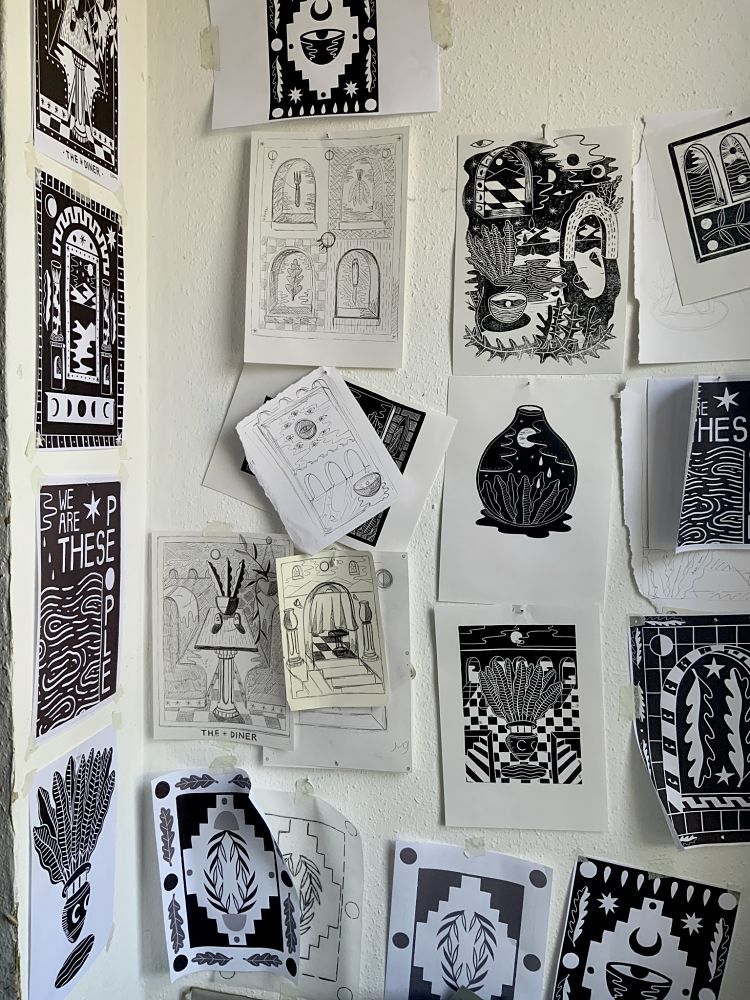 Over the years Emily has experimented with many different printmaking techniques; “I always loved the magic of it but I just didn’t have the tools or the facilities to carry on with that side of my practice”. In 2019 she started a storytelling project for Walthamstow Art Night with artist collective Hewing Wittaire. At the time she was creating a lot of large scale paintings and was looking for a way to scale down her work without losing her style. Emily tried lino printing and immediately fell in love with the process. “I love how accessible it is and the way the lines and carvings form on the page works so well with the imagery I use,” says the printmaker. Now, her practice predominantly focuses on this medium.
Over the years Emily has experimented with many different printmaking techniques; “I always loved the magic of it but I just didn’t have the tools or the facilities to carry on with that side of my practice”. In 2019 she started a storytelling project for Walthamstow Art Night with artist collective Hewing Wittaire. At the time she was creating a lot of large scale paintings and was looking for a way to scale down her work without losing her style. Emily tried lino printing and immediately fell in love with the process. “I love how accessible it is and the way the lines and carvings form on the page works so well with the imagery I use,” says the printmaker. Now, her practice predominantly focuses on this medium.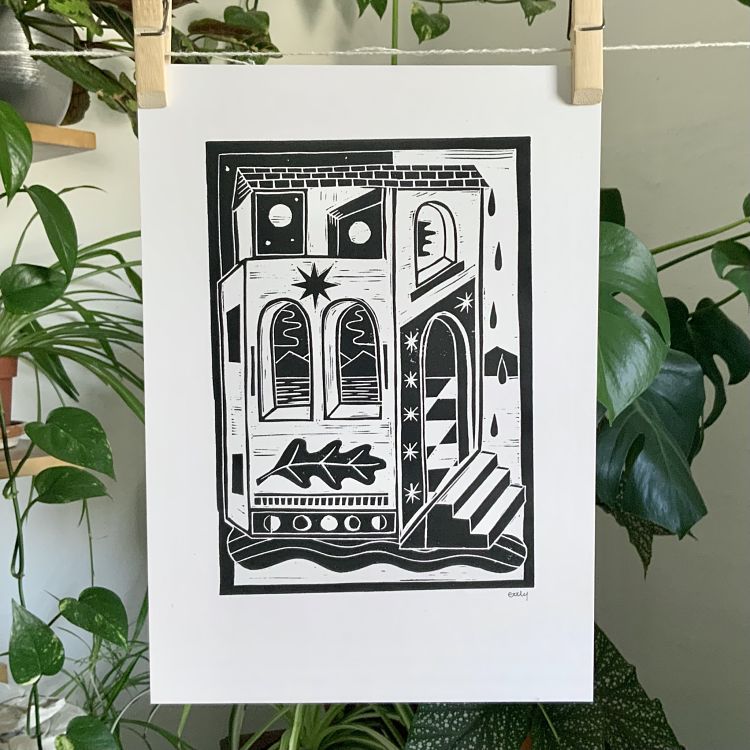
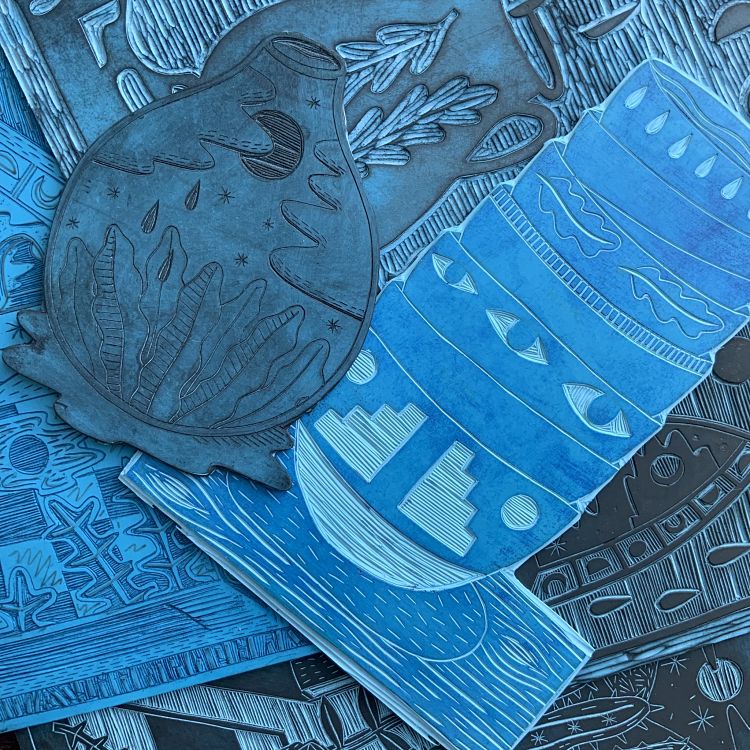 “My style has really developed over the last two years,” comments Emily. She made a journey from a typical fine art background, creating work for a gallery setting, to producing much more illustrative pieces. “There are definitely elements from my old work that marry into the new,” explains Emily. She continues; “I have always been interested in how objects and symbols interact with one another. I would say I have built up a kind of library of images and icons that come from all kinds of eclectic sources. I like to play around with how they work together in an image and what kind of story they tell when they are placed in a certain way.” Her sources of inspiration are far and wide reaching, including everything from metaphysical and surrealist art, to old comic strips, botany and folklore. “I am always on the lookout for new material and I can be inspired by just about anything. A new leaf I see on a walk in the woods or a feature on a building I hadn’t noticed before.”
“My style has really developed over the last two years,” comments Emily. She made a journey from a typical fine art background, creating work for a gallery setting, to producing much more illustrative pieces. “There are definitely elements from my old work that marry into the new,” explains Emily. She continues; “I have always been interested in how objects and symbols interact with one another. I would say I have built up a kind of library of images and icons that come from all kinds of eclectic sources. I like to play around with how they work together in an image and what kind of story they tell when they are placed in a certain way.” Her sources of inspiration are far and wide reaching, including everything from metaphysical and surrealist art, to old comic strips, botany and folklore. “I am always on the lookout for new material and I can be inspired by just about anything. A new leaf I see on a walk in the woods or a feature on a building I hadn’t noticed before.” Emily tells us that “the pandemic has completely changed the trajectory”, meaning that the past two years have provided the most notable elements of her career. Currently, she works for herself full-time; “whilst it can be terrifying and uncertain, it has given me the freedom to take on opportunities and projects I would never have had the time for in the past”. Notable recent projects include a commission for musician Edward Randell, creating a cover piece for his EP Almanak. She is also excited to get back into workshops and markets; “community and connection is so important to me and it’s brilliant to be able to meet new people and share creative skills”.
Emily tells us that “the pandemic has completely changed the trajectory”, meaning that the past two years have provided the most notable elements of her career. Currently, she works for herself full-time; “whilst it can be terrifying and uncertain, it has given me the freedom to take on opportunities and projects I would never have had the time for in the past”. Notable recent projects include a commission for musician Edward Randell, creating a cover piece for his EP Almanak. She is also excited to get back into workshops and markets; “community and connection is so important to me and it’s brilliant to be able to meet new people and share creative skills”.



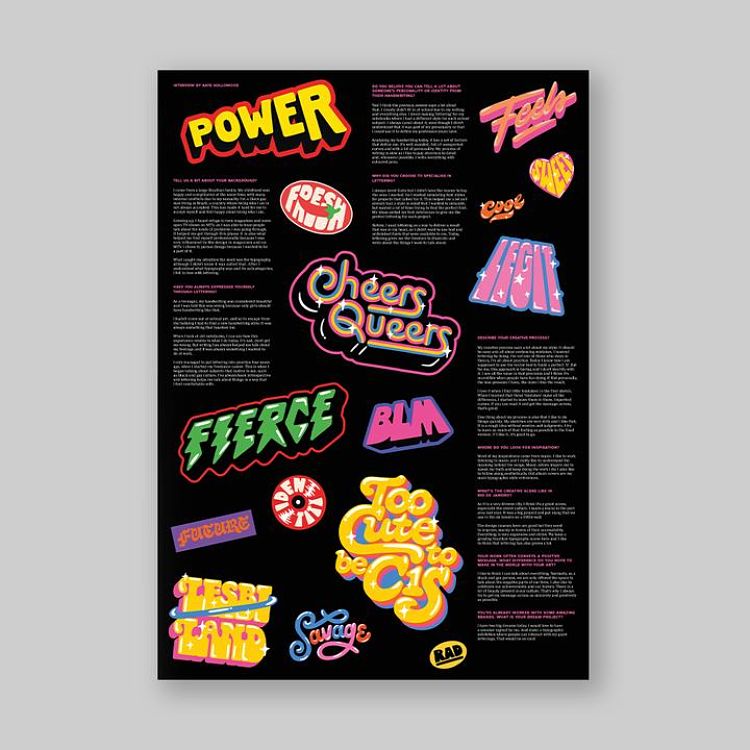 Leandro started out working
Leandro started out working 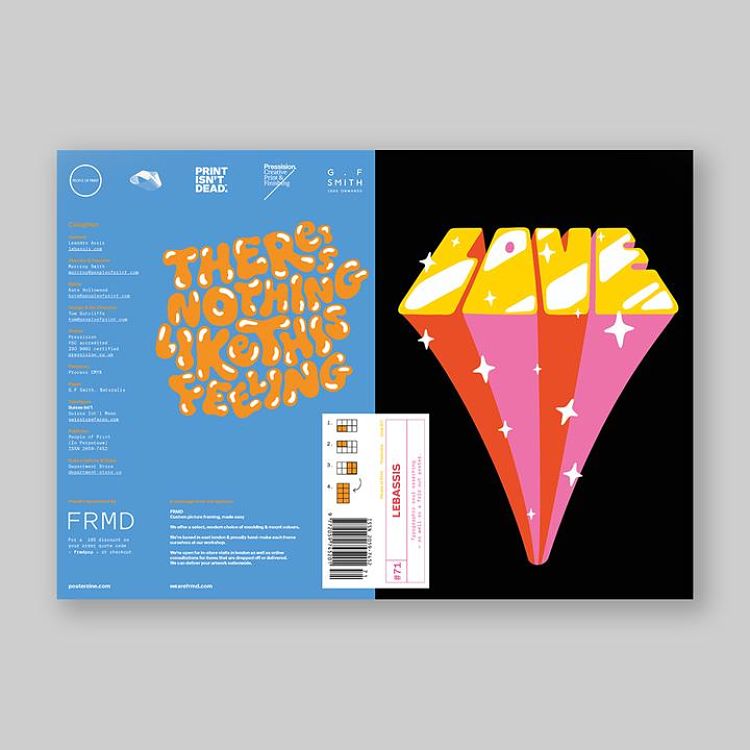 Issue 71 was printed by
Issue 71 was printed by 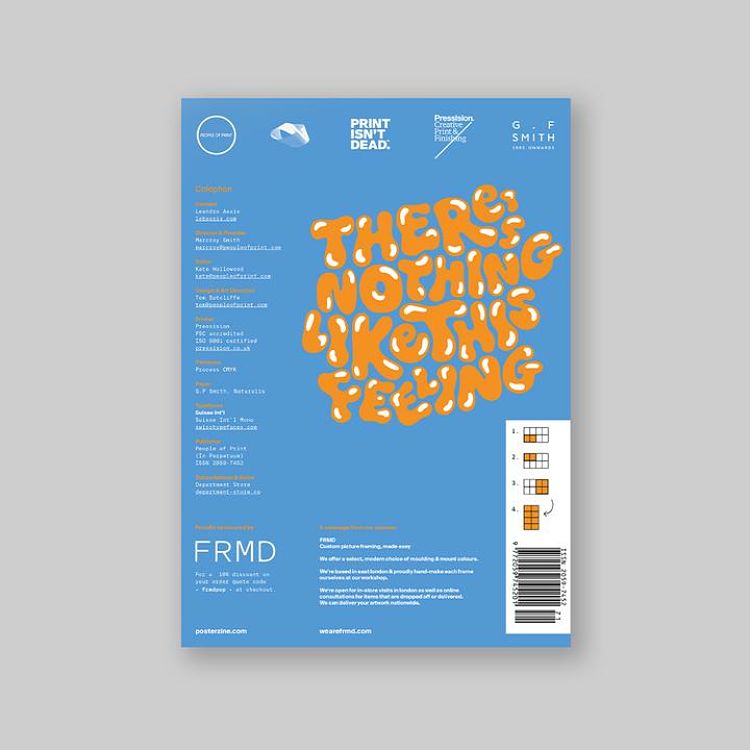 Grab your copy
Grab your copy  RSS Feed
RSS Feed
